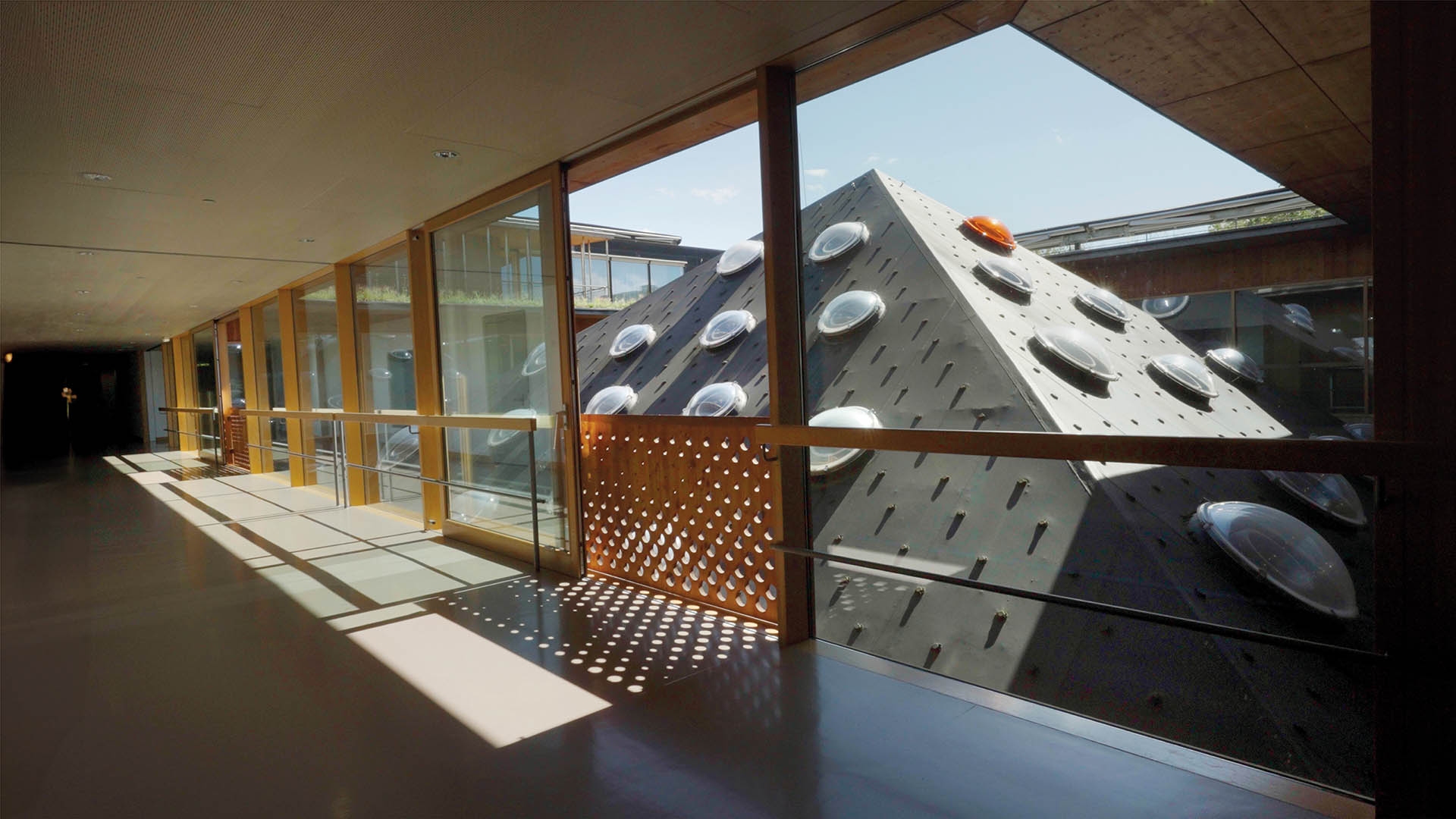

Filmmakers Ila Bêka and Louise Lemoine reveal the behind-the-scenes of Rehab (From Rehab). Winner of the latest Venice Architecture Film Festival, the documentary explores architecture, bodies, and universal design.
Rehab by Ila Bêka and Louise Lemoine twists together a deeply personal sequence of events. Growing up while your father was in and out of rehabilitation centers, and by using your own story, your film focuses on the role of architecture in creating spaces of care for vulnerable people. Rehab is a thought-provoking film that addresses the intersection of architecture and healthcare, exploring the emotional as well as the functional dimension of care and rehabilitation.
When Herzon & de Meuron came to us to discuss the possibility of a film in the rehabilitation hospital in Basel, Switzerland, it presented as a real challenge. I was so ready to go back in a sort of emotional memory of everything I went through with my father.
Making Rehab must have been an incredibly emotional journey for you, creating a continuous back-and-forth into memories, reflections, and questions about the past and future possibilities in relation to rehabilitation and the space to serve it. How did the architecture and design of these spaces affect your sense of safety, comfort, and healing as a child? Were there particular architectural elements that stood out to you in shaping your experience?
Louise Lemoine_This is a film which is quite singular in our filmography. I had an attachment to this project because it really resonated strongly with my personal story. When I was around ten years old, my father had a tragic accident. He lived for ten years afterwards, hospitalized most of the time. So, it’s true, the world of hospitals and questions of care of vulnerable people was really my world. And then I turned twenty years old.
When Herzon & de Meuron came to us to discuss the possibility of a film in the rehabilitation hospital in Basel, Switzerland, it presented as a real challenge. I was so ready to go back in a sort of emotional memory of everything I went through with my father. It would have been really, really interesting for me, even if I have to say that the hospital, the kind of hospitals we went to with my father, were far from being exceptional structures like this one is. It was an opportunity to come back to old memories in very different ways because this rehab hospital is exceptional for many reasons, not only for its architecture, but also for its sort of vision, by the former director, to approach a rehab centre in a sort of holistic way, not only for the quality of the spaces you can offer to patients, but also the quality of treatments and a global approach of well-being of the patient as a condition to improve your opportunities of healing. That’s why I was really amazed by this place. And I think globally, most of the people who had to go through rehab do not have the same kind of experience. I loved making a film in a hospital that can be a model for the improvement of these kind of structures, taking into consideration not only treatments and technology that the hospital has to constantly modernize, but also this really caring approach of the human as a whole.
I think what all of us recall of hospitals is that they share certain architectural features which make these places horrible. First of all, they are thought of as efficient machineries. Machines rather than spaces, because they must meet high standards of hygiene, stress, circulation. The way they are designed is rationalized to the extreme. In a rehab centre, you don’t have this level of need regarding urgencies, you can play a little with these rules.
What I remember mostly from my childhood was sterile spaces because of their lighting and colours, and also spaces made of corridors, endless corridors. You enter a sort of administrative nightmare. That nightmare is a bit the same when you go to the tax office, or yes, to hospitals.
In this line of narration in the film, which is a second line of narration from what we shot in rehab, we try to show that when you enter this kind of process in a hospital you become yourself a number rather than a human, because hospitals have to deal with so many people. This is the question of how hospital dehumanize us in a certain way. The rehabilitation hospital in Basel is a small structure, allowing approximately a hundred patients in. When you work with small numbers, you can think in different ways and in which you really address the person as an individual.

The space itself can play an important role in shaping our perceptions of care. In Rehab, you explore how the design of rehabilitation centers can affect patients’ sense of dignity and humanity. How do you think the role of architecture and architectural design can today influence the way we perceive disability and the healing in society at large? We spoke earlier of a structure hosting hundred people, but then how can we wish it for larger numbers?
I don’t know if architecture can play a role in the way we perceive disability. Surely someone who is facing disability can be helped by design and architecture to have an easier life; if you make their life even more complex because of complex or non-suitable spaces, they will struggle even more. Of course, if architecture can facilitate the already complex life by the full process of understanding what does it mean to get around on a wheelchair or if you are blind, or in case of any disability, this becomes a practice of inclusive care. This is a process that already started: as soon as something new gets built, suitable access in any public spaces is granted. But this is the start of a process. We made several films on people facing disabilities and each time they express how difficult it is to navigate cities. Buildings are very specific places, and their accessibility can be improved with known methods (think about elevators, ramps etc.). When you deal with the city landscape, it’s a whole different story. For instance, we lived in Rome for five years, and this is insanely complex for someone in a wheelchair. On one side because the configuration of the city, but also the lack of collective understanding of these kinds of needs: people park on the sidewalks, on the pedestrian crossings… It shouts out how much we care so little about these things. We were with our little Adrian at that time in the stroller in Rome and we could understand how difficult these things are. Not to mention Venice, of course! I think it’s also a cultural factor, the visibility of disability is very different from one country to another. How we encourage a sort of global sense of care or otherwise we try to hide disability as something we should be ashamed of. This is a very complex and large-scale question of how we globally deal with question of vulnerability. It’s a real question, more than for the scale of architecture, for the urban scale.

Cinema and films have the power to evoke, entertain, move, advocate and make us reflect upon different meanings. Given the challenges that healthcare systems around the world face, adapting to the new needs of our societies, such as aging population, overcrowding, limited resources, new therapies. In your opinion, what are the most urgent design challenges and aims for architects working in healthcare today? Are there any changes or innovations you hope to see in the future of rehabilitation and care environments for larger masses?
Although I’m not a professional architect, nor specialized in hospitals, what we tried to capture with our film Rehab, is presenting the centre as a proposal of a model. The architects and the whole team at the rehab structure together try to develop an approach whereby the human being is considered and taken care for as a whole and not just a body to repair a physical matter. They understand that the psychological condition of a patient, how influential his environment can be, the kindness of the staff, and the quality of the architecture are important in his process of healing. This Rehab centre points out something that is totally forgotten in other kinds of structures: the psychological and emotional impact of architecture and how much you can affect the life of people by giving importance to immaterial aspects of architecture rather than focusing on the functional matters.
The way you design the space, how to choose lighting, openings, natural elements in a building rather than just purely mineral elements… all these little factors can make a difference. These are very small choices, but when you think of a hospital, you visualize this sort of administrative spaces, lines on the floor, signage everywhere. In the film, the rehab centre has no signage. They wanted to welcome people in a place that doesn’t look at all like a hospital with all the usual characteristics of a hospital. They thought the signage would work with recognizable elements from nature, so you have a courtyard with water, or with trees as reference points of the spaces. Rather than being in an administrative environment, you naturally focus on natural elements, which also bring some sense of peace and well-being.
Of course, this is not easy to do, though we all know that in Europe, medical structures are constantly under pressure, and we are in the midst of global crises. This small example shows so clearly how efficient, how powerful these elements and consideration in the making of such a facility, including this consideration about the emotional impact of space, can be successful.

The concept of adaptation is at the heart of today’s urban and architectural discourse. Adapting to a changing world requires collaboration. How does your production in a broader sense can help portray the role of communities, governments, and individuals in creating sustainable spaces and cities? What kind of relationships and efforts are necessary for successful adaptation?
I think honestly, we fit very well in this theme of Adaptation. We could potentially reduce our entire production of over 30 films to focusing on this real question of how we adapt to spaces made by others. Rarely are we in the situation of living in spaces we have consciously thought about and designed for our needs and ourselves and our well-being. We mostly inherit spaces from even remote past. In Europe we live in cities that have been built over centuries. We must constantly adapt to spaces. It’s so interesting, we’ve witnessed something like this also in India, where you have a specific word, jugaad, to define the playful inventiveness of people, the ability to find solutions to spatial issues or design issues. They not only repair things constantly, but also alter and upgrade what doesn’t work. We dealt with this question of adaptation in many different scales, from the domestic up to the urban, each time trying to carefully observe these subtle expressions and forms in which you understand how this alchemy works. This will mostly create positive results, though not always. We are so interested to understand how these forms of immaterial and invisible impacts of space on our state of mind and on our quality of well-being. For instance, in the series of film Homo Urbanus, each film out of fourteen is a deep dive into cities around the world, documenting how people adapt, endure or have the ability of transforming or inventing forms of their own adaptation in the urban environment. It’s so interesting to see all these facets of the adaptation process. Do we react actively or passively?